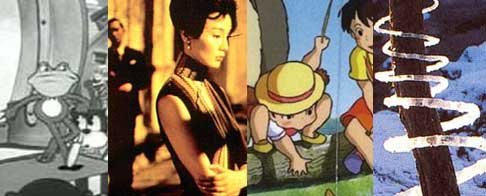
Pictured: Art I admire
This is the second post in a series describing the creative process behind my graphic novel Tonoharu. This installment covers the formation of the basic idea.
******
If there’s a common thread to the experiences in my adult life that get me excited in a kid-on-Christmas kind of way, it’s those that make me feel like the world is a big, terrible, exhilarating place with untraveled roads, fascinating strangers, and infinite possibilities.
“Feel” is the key word here. It’s easy to duly profess the belief that there’s a world of possibility beyond your front door, but I’m not talking about an uninspired intellectual awareness. I’m talking about when you feel it in your guts, when you’re intoxicated by curiosity about what might be around the next corner.
Works of art that are important to me evoke a similar kind of excitement. Max Fleischer cartoons, Knut Hamsun books, Hayao Miyazaki animated features, Wong Kar-Wai movies, Harry Smith’s Anthology of American Folk Music, Andy Goldsworthy’s Rivers & Tides… These works of art take different approaches to their respective subject matters, but they all are alike in that they make the world seem broader in a visceral way.
When I first arrived in Japan in 2003, I knew I was going to devote my free time to a graphic novel. I didn’t really have any ideas in terms of content at that point; just the sense that I wanted to create something that would foster the aforementioned feeling.
With this in mind, I started to shape the basic idea in my mind. Not really in the form of a story, but rather as a vague laundry list of things I thought might be interesting to write (and read) about.
From the get-go I knew that foreign travel would somehow play a key role. Travel has been a defining aspect of my life since high school, and what with me living in Japan, its inclusion was obvious. In the spirit of “writing what you know”, I decided to put the main character in a set of circumstances very similar to my own: a twenty-something American uprooting his life and moving to rural Japan.
But I didn’t want to write a straight-up autobiography. I liked the idea of letting the story go off in its own direction, and of including little surrealistic touches. Nothing too over the top or too central to the story, just little things off to the side. Most of this was realized in the creation of fictional group of eccentric expatriates living in the same town as the protagonist.
After a couple months of lazy rumination, I had a few characters, a location and the vaguest sense of where the story might go, but it was all still pretty fuzzy at that point. Brainstorming was beginning to produce diminishing returns. It was time to sit down and commit something to paper.
The process of which I’ll cover next Friday in Creating Tonoharu: #3–Writing the Script.
Creating Tonoharu–#1: Laying The Groundwork
Creating Tonoharu–#2: The Idea
Creating Tonoharu #3–Writing the Script
Creating Tonoharu #4–The Design (1/3)
Creating Tonoharu #5–The Design (2/3)
Creating Tonoharu #6–The Design (3/3)
Creating Tonoharu #7–The Drawing
Creating Tonoharu #8–Inking
Creating Tonoharu #9–Computer Stuff
Creating Tonoharu #10–Final Edits
